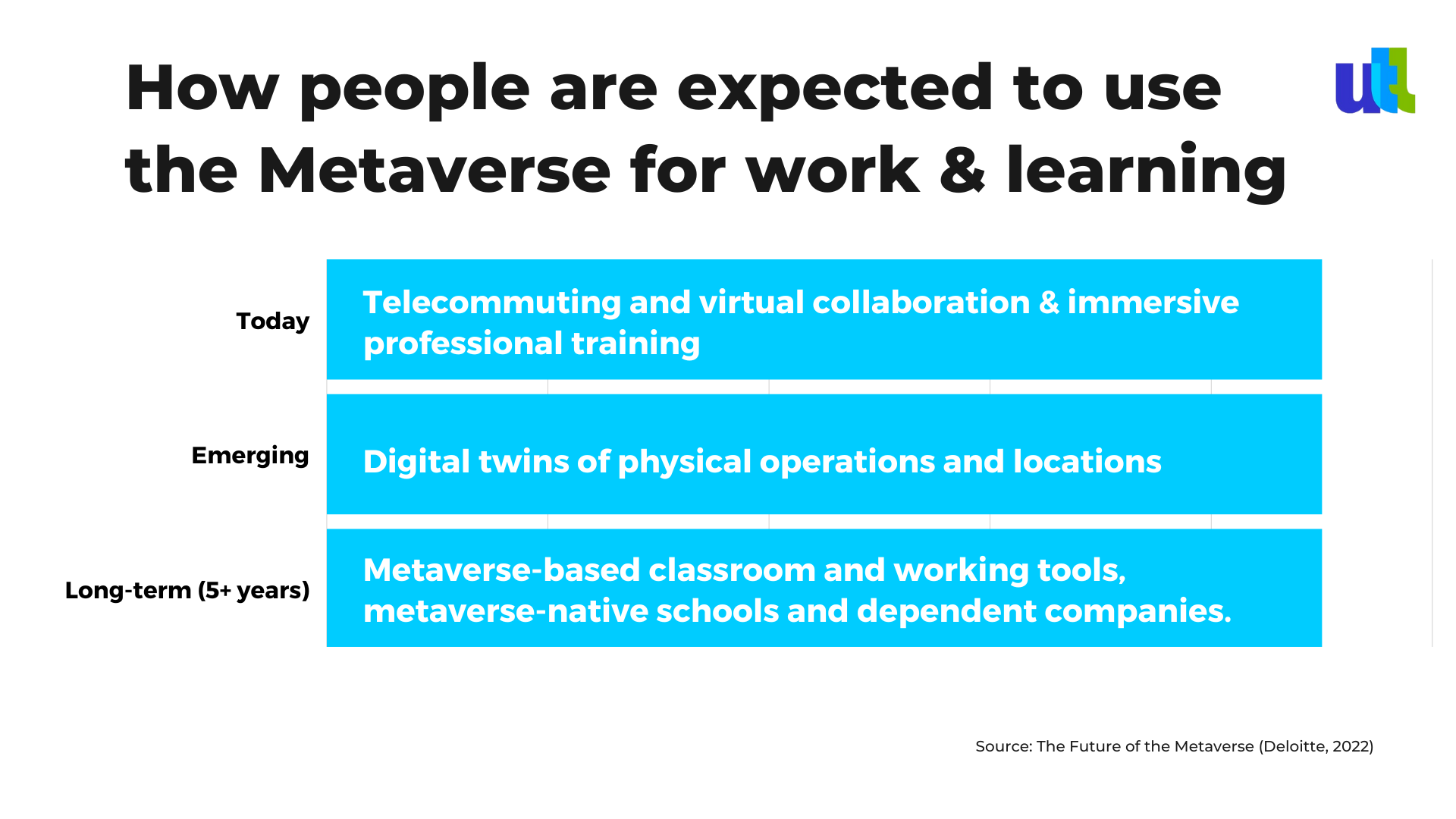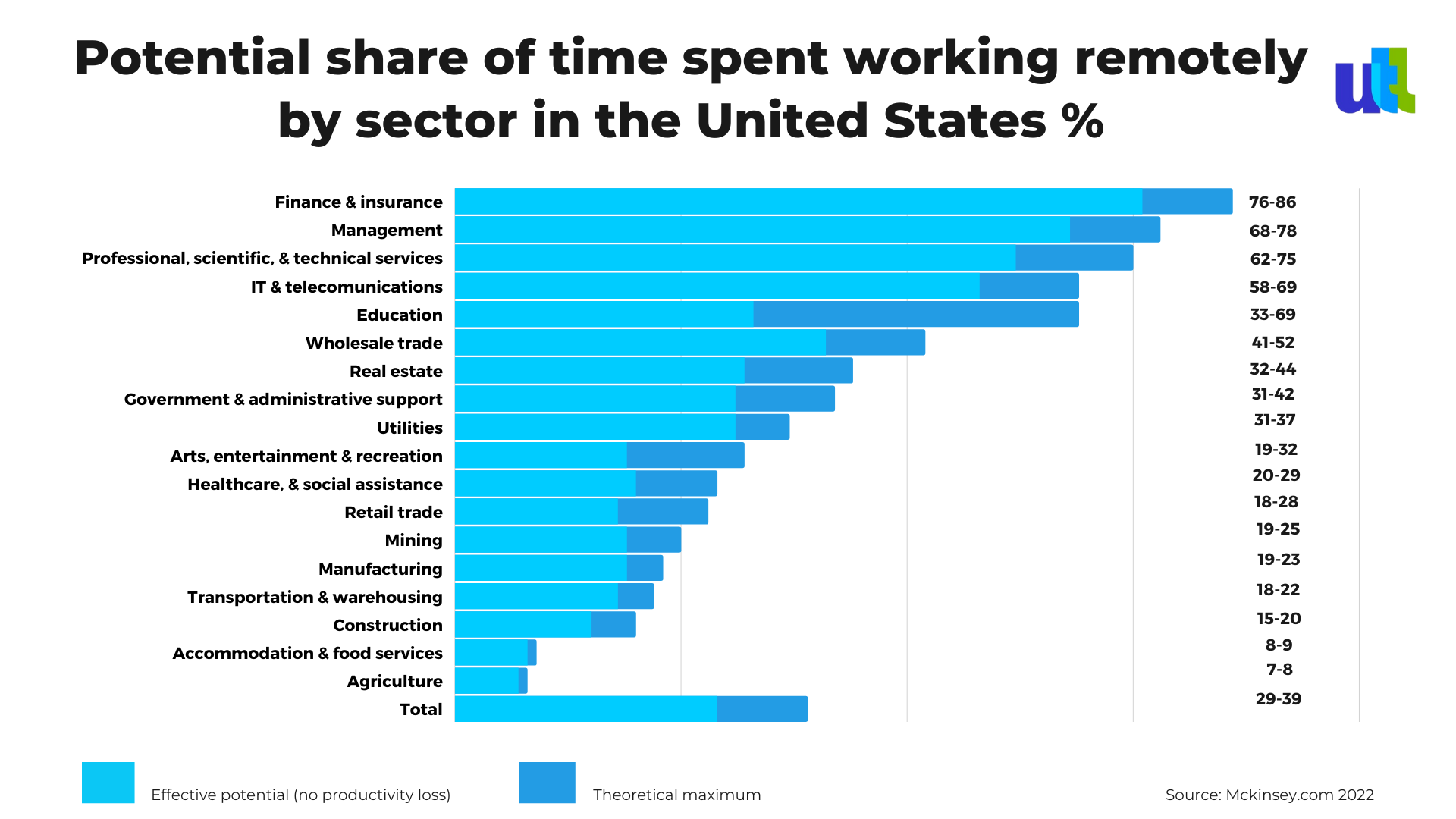In this article, we'll cover:
- What are the Metaverse opportunities for work?
- The current challenges for distributed teams
- In which ways the Metaverse is reshaping the future of work
- New immersive forms of team collaboration
- Digital colleagues
- Faster Learning in the Metaverse
- The eventual rise of the Metaverse economy
- New jobs are driven by the Metaverse advancements
Imagine a world where you could have a beachside conversation with your colleagues, take meeting notes while floating around a space station, or teleport from one office to another, all without taking a step outside your front door.
These examples offer but a glimpse into the future vision of work promised by “the metaverse,” a term originally coined by author Neal Stephenson in 1992 to describe a future world of virtual reality.
The precise definition of the metaverse is generally a network of 3D virtual worlds where people can interact, do business, and forge social connections through their virtual unique “avatars.” Think about it as a virtual reality version of today’s internet that is easily accessible from any device like a desktop or mobile.
Since the beginning of 2020, flexible scheduling and working from home have quickly become the new normal for many companies. And many of them plan to continue allowing remote work or hybrid options post-pandemic.
Remote work may be more common than it used to be, but it still comes with its challenges. This calls for technological change and advancements for the new reality.
The challenges based on our experience and listed in numerous studies on remote working include:
- Managing projects
- Remote collaboration
- Tracking tasks and productivity
- Working from different locations, time zones, etc.
- Dealing with language and cultural differences
- Building/maintaining trust
- Productivity levels at home
- Overcoming distractions
- Staying motivated
- Unplugging after work
- Fun activities and teambuilding
Curious to know more about the impact it can bring to your organization?
The effects of the pandemic — especially limitations on physical meetings and travel, as well as the other challenges mentioned above — are spurring a search by enterprises for more authentic, cohesive, and interactive remote and hybrid work experiences.
The world of work is possibly where the metaverse will have the greatest impact. Building on trends of remote work stemming from the pandemic, providing the in-person contact and the spontaneity it affords with the freedom to work from wherever, whenever could be truly revolutionizing for companies and employees.

Bill Gates predicts change is coming faster than you might think.
“Within the next two or three years,” Gates writes on his blog, “I predict most virtual meetings will move from 2D camera image grids […] to the metaverse, a 3D space with digital avatars.”
The Metaverse seems set to reshape the world of work in at least four major ways:
- new immersive forms of team collaboration;
- the emergence of new digital, AI-enabled colleagues;
- the acceleration of learning and skills acquisition through virtualization and gamified technologies;
- and the eventual rise of a metaverse economy with completely new enterprises and work roles.

A preview of our award winning remote work metaverse product Future Work Land
The Metaverse for companies – new immersive forms of team collaboration
Until now, technology has served mainly to keep communication and interaction at work functioning despite physical distance rather than replicating the experience of being present with team members in person.
- Virtual work currently comes at the cost of easy reading of body language, and the spontaneous sharing of ideas as you pass a colleague in the hall.
- In the Metaverse, we can join our team members in virtual workspaces as 3D avatars, in a way that far more closely feels like the real world.
- Guarantees physical safety from transmittable viruses and illnesses.
- Frees employees up from tedious daily commutes, in-person meetings, expensive business trips, and professional office apparel.
Like being there: digital colleagues
It is essential to bring new levels of social connection, mobility, and collaboration to a world of virtual work.
The metaverse opens new possibilities to rethink the office and work environment, introducing elements of adventure, spontaneity, and surprise. A virtual office doesn’t have to be a drab, uniform corporate environment downtown: why not a beach location, an ocean cruise, or even another world?
Virtual avatars, common zones, and the possibility to organize team-building and after-work activities in the virtual space create PRESENCE and solve many communication-connected challenges.
Employees choose an avatar and navigate to their desks via elevators and corridors. When they meet a colleague’s avatar, their mic (and webcam) is activated so they’re able to have a conversation. Then they turn off automatically as their avatar walks away.
Emotions and presence are the next frontiers in the Metaverse.
Faster learning in the Metaverse - acceleration of learning and skills acquisition
The metaverse could revolutionize training and skills development processes, drastically compressing the time needed to develop and acquire new skills.
Virtual reality role-play exercises and simulations will become common, enabling worker avatars to learn in highly realistic, “game play” scenarios, such as “the high-pressure sales presentation,” “the difficult customer,” or “a tough employee conversation.”
Without borders - the eventual rise of a metaverse economy
It’s not all fun and games in the metaverse. The vast world of virtual reality can also offer companies opportunities to find solutions online to apply to the real world.
Human connections are necessary for people to thrive. The metaverse can help foster the human connections that people working remotely look for. Instead of a Zoom meeting, imagine joining an immersive virtual meeting as an embodiment of yourself with an avatar. As an avatar, you can interact with others, and present your ideas in the meeting via visual and spatial-audio connections. Isn’t it a very similar feeling to interacting with a colleague in a physical office?
The metaverse will allow companies to save time, cut down on travel costs, and encourage connections that may not have been possible before. And, thus, driving the rise of the Metaverse economy.
And, of course, as the Metaverse space grows and develops, so will the opportunities. New jobs driven by technological advancements will be created. Demand will be increased for people knowledgeable about the space.
Here are a few opportunities to look out for in 2022: play-to-earn gamer, digital fashion designer, smart contract lawyer, Metaverse engineer, and crypto payments specialist. And there already are and there will be so many more.
The Metaverse opportunities for work are now mostly represented by the advanced digital office solutions
Such virtual work software can boost your remote team’s success by helping both in-house and off-site teams stay connected on projects regardless of their proximity. The right remote software can even help you maintain a strong company culture and increase employee engagement when your teams work from home.
Which virtual work software to choose?
We’ve compiled the list below to help you answer this question.
Use these examples to find the best solution aligned to your goals, budget, and company culture.
Advancements in technology are difficult to opt out of without falling behind
Space is not an issue in the Metaverse. Virtual workspaces can be expanded easily, while the tasks – delivered faster. And there’s less need for hardware. Working in the Metaverse will require minimum equipment, while 3D avatars are free and allow you to meet “face to face” without the need for conferencing equipment.
As the world progressively moves towards a post-pandemic era, technology is also significantly changing the human experience in the physical and digital worlds. If it delivers as it is promised, we will be able to have both a real-world more on our own terms as far as location and work/life balance, and an interactive, dynamic world of work in which we collaborate and create in virtual spaces with more true-to-life connections through technology than we could ever think before.
Let's setup your virtual office.
----------------------------------------------------------------------------------------------
View the full presentation:
WRITTEN BY
Sofia Kutko
2022-08-31


































































































































































































